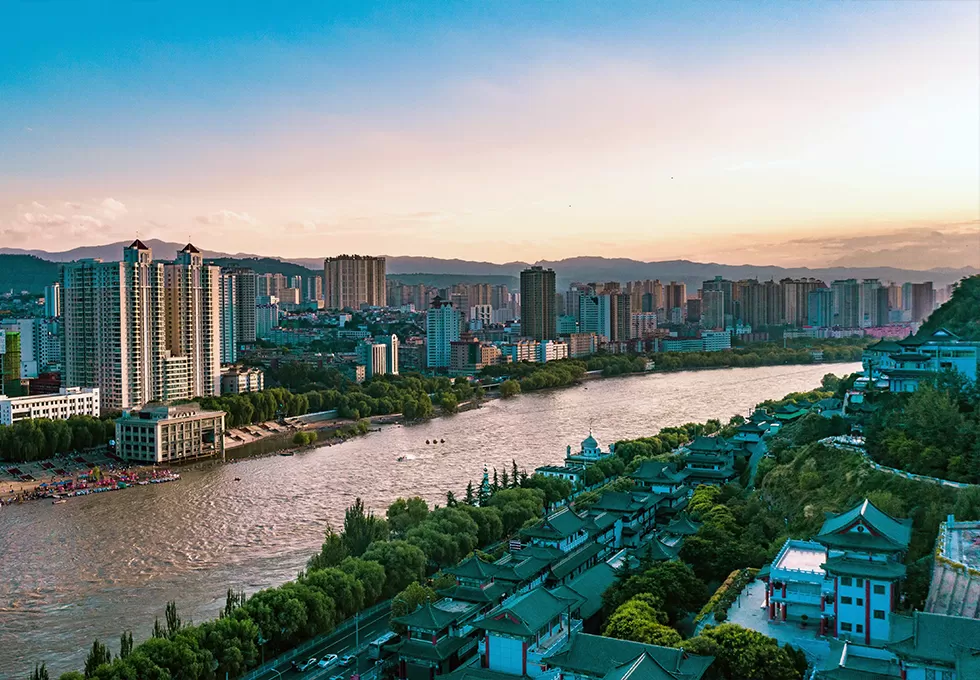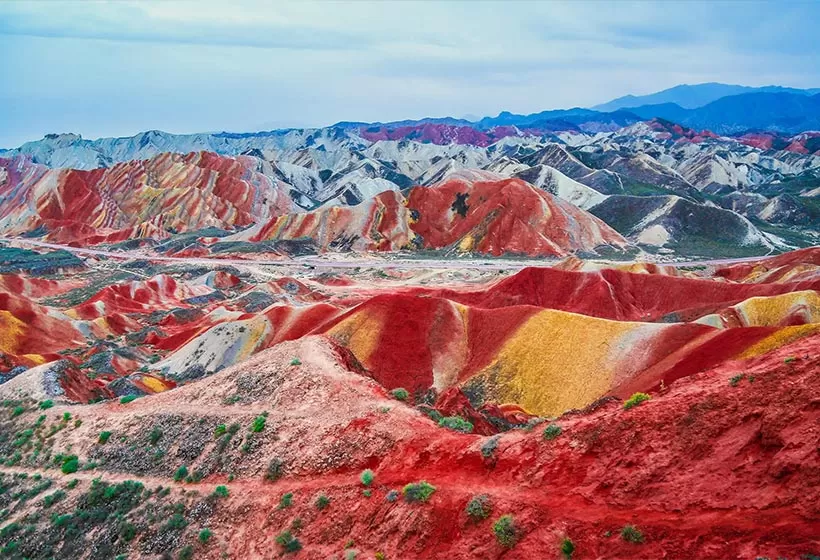Top 10 Famous Tourist Attractions and Sightseeing in Lanzhou
Lanzhou, formerly known as "Jincheng", is located along the banks of the Yellow River. As a famous historic and cultural city, it boasts a long-standing history and culture and is celebrated as the "Pearl of the Yellow River" due to the river flowing directly through the city. Following are the Lanzhou top 10 attractions.
Top 1: Yellow River Iron Bridge
Lanzhou Yellow River Iron Bridge, known as the "First Bridge over the Yellow River," was designed by an American company, constructed by both German Telge & Schroeter and Chinese craftsmen. In 1928 in order to commemorate Sun Yat-sen, it also gained the name of "Zhongshan Bridge". Spanning 233.5 meters and 8.36 meters wide, it is the first bridge in northwestern China built with foreign technology, making it a key to studying modern history and giving it a unique position in China's architectural history.
This bridge employs a trapezoidal through-type steel truss structure that not only ensures the bridge's stability but also endows it with a unique artistic aesthetic. The perfect fusion of Western modern bridge technology and traditional Chinese architectural elements makes Zhongshan Bridge stand out among many others. Standing on the bridge, one can almost hear the bustling and vibrant sounds of the past, feeling the pulse of history reverberating through time.
At night, the Yellow River Iron Bridge glows magnificently, resembling a golden dragon resting over the river. The dazzling bridge, the tranquil Yellow River, and the misty mountains are integrated and familiar with the city over centuries of history, permeating the atmosphere of culture and modern city.
- Address: The middle section of Binhe Road under Baita Mountain, Lanzhou
- Open Hours: 00:00 AM – 12:00 PM
- Tour Length: 1 hour
Top 2: White Pagoda Mountain Park
White Pagoda Mountain Park, located in the northern part of Chengguan District, Lanzhou City, Gansu Province, is named after the White Pagoda Temple situated at its summit. The combination of the pagoda and the Lanzhou Yellow River Iron Bridge creates a majestic scene, making it one of the symbols of Lanzhou.
The terrain of White Pagoda Mountain is rises and falls, coiling with suburbs. The White Pagoda Temple, originally built in the Yuan Dynasty and reconstructed in the Ming Dynasty, has a rectangular layout. The White Pagoda itself, standing at about 17 meters tall with seven tiers and eight sides, is topped with a green spire and rests on a round base, with whole white body giving it straight and elegant. The pagoda embodies intricate architectural design and exquisite sculptural art, reflecting the ingenuity and artistic creativity of ancient laborers, marking it as a masterpiece of ancient Chinese architecture. From the summit of White Pagoda Mountain, visitors can enjoy a panoramic view of Lanzhou's cityscape.
- Address: No. 1 North Binhe Middle Road, Chengguan District, Lanzhou
- Open Hours: 06:30 AM – 07:30 PM
- Tour Length: 2-3 hours
Top 3: Gansu Provincial Museum
The Gansu Provincial Museum, covering a total area of 43,000 square meters, was formerly the Gansu Science and Education Museum, founded in 1939, with over 80,000 invaluable historical relics, including 16 classified as national treasures. The museum's collection highlights Neolithic painted pottery, Han Dynasty bamboo slips, Silk Road artifacts from the Han and Tang dynasties, Buddhist art, and ancient fossils.
The museum’s main exhibition building, designed to be “dignified, elegant, beautiful, and friendly,” is a modern, comprehensive smart structure. It spans 28,000 square meters in an epsilon-type structure, with collection storage covering 7,600 square meters and exhibit halls approximately 9,000 square meters. The central structure has five floors, flanked by three-story wings, with an exhibition hall behind and a circular lecture hall in the rear.
Due to the rich cultural heritage of the Long Plateau region, the Gansu Provincial Museum has a vast collection spanning from ancient times to the present. This museum preserves the legacy of Gansu and even Chinese civilization, drawing numerous visitors and scholars. A visit to the museum, to explore its historical relics and the cultural lineage of this land, promises to be a memorable journey through time.
- Address: No. 3 Xijin West Road, Qilihe District, Lanzhou
- Open Hours: 09:00 AM – 05:00 PM around Tuesday to Sunday
- Tour Length: 3-4 hours
Top 4: Statue of Mother Yellow River
The Statue of Mother Yellow River is located on the southern bank of the Yellow River along Binhe Road and on the north of the Little West Lake Park. Renowned as one of the most beautiful sculptures representing the Yellow River, China's "Mother River", the statue is 6 meters long, 2.2 meters wide, and 2.6 meters high, weighing over 40 tons. It features a composition of a "mother" and an "infant", symbolizing the life-giving Yellow River nurturing the Chinese people and the joyful, thriving descendants of the Chinese civilization.
Crafted from ordinary granite, the material not only resembles the Yellow River's color but also reflects the skin tones of the Chinese people, while the rough texture of granite conveys the centuries of trials and transformations experienced by the Chinese nation. The statue’s base is adorned with wave and fish patterns inspired by ancient Gansu painted pottery, reflecting Gansu's rich cultural heritage and illustrating early Chinese ancestors' keen observations of nature.
- Address: middle of Riverside Road, Qilihe District, Lanzhou
- Open Hours: 00:00 AM – 12:00 PM
- Tour Length: 1 hour
Top 5: Ink Danxia Scenic Area
The Lanzhou Ink Danxia Scenic Area is located at the intersection of the Qilian Mountains and the Loess Plateau, and it is one of China’s largest, most complete, and best-preserved examples of this kind of Danxia landscape. Formed during the Cretaceous to Tertiary periods, it was shaped by the uplift of red sandstone during the Himalayan orogeny and subsequently eroded over time by wind and water to create the geological wonders.
The scenic area is dominated by the Red Mountain Bay terrain, featuring various strange landscape as a natural record of geological history. It is a rare, pristine natural formation in the arid northwest—a true masterpiece among Danxia landscapes.
Standing atop an observation platform, one can gaze out over this grand, three-dimensional landscape that resembles an ink painting. The entire Danxia landscape lies nestled below, with towering, vivid red peaks arranged in striking formations, each showcasing its unique and colorful beauty against the vast red hills reaching into the sky.
- Address: No. 1 community 2, Xinghua village, Yongdeng County, Lanzhou
- Open Hours: 09:00 AM – 05:00 PM
- Tour Length: 4-5 hours
Top 6: Zhangye Road
Zhangye Road, located in Chengguan District, is part of Lanzhou's Xiguan commercial area and serves as the city's landmark and central business district core. Known as Lanzhou's oldest commercial street, Zhangye Road—formerly named Zhonghua Road—was a bustling avenue from the Ming Dynasty to the Qing Dynasty. Historic sites such as the Chenghuang Temple, the Ming-era Suwang Palace, and the Qing-era Gansu Provincial Office were located here.
As Lanzhou’s Wangfujing, Zhangye Road is rich in cultural background. The constant flow of people and cars blends with the timeless presence of historical sites like the Chenghuang Temple, that is the convergence of new and old and the harmony of liveliness and tranquility. Though today's pedestrianized Zhangye Road may not retain its former grandeur, it remains deeply cherished by the people of Lanzhou, holding a nostalgia that cannot fade. Wandering down this street, one might pause for a refreshing apricot tea—an emblem of youthful days when people strolled along Zhangye Road, savoring sweet and tart sips, footsteps light and filled with romantic music and dreams.
- Address: Zhangye Road, Chengguan Distinct, Lanzhou
- Open Hours: 10:00 AM – 10:00 PM
- Tour Length: 4-5 hours
Top 7: Wuquan Mountain Park
Wuqian (Five Springs) Mountain Park, located on the northern slope of Gaolan Mountain in Chengguan District, is celebrated as the top park in Gansu, derives from five famous springs: Hui, Ganlu, Juyue, Mozi, and Meng Springs. Legend has it that in 120 BC, the general Huo Qubing camped here while advancing west. His soldiers, exhausted and thirsty, were saved when Huo supposedly struck the ground five times with his whip, causing the five springs to gush forth.
Wuquan Mountain Park centers around these five springs and historic Buddhist structures. Temples were originally built here during the Tang and Song dynasties but were later destroyed in conflicts. The current structures mostly date back to the Ming and Qing dynasties, giving them a history of over 600 years and a distinct local flavor rich in cultural depth. With winding paths, serene settings, and beautiful scenery, Wuqian Mountain can be explored along three routes—western, central, and eastern—each featuring pavilions, towers, gallery road, and clear waterfalls, each of them has distinct layouts and own systems.
- Address: No. 103, Wuquan South Road, Chengguan District, Lanzhou
- Open Hours: 08:00 AM – 08:00 PM
- Tour Length: 2-3 hours
Top 8: Xinglong Mountain
Xinglong Mountain, located 5 kilometers southwest of Yuzhong County, and about 60 kilometers from Lanzhou, has an elevation of 2,400 meters. Acclaimed as the "Top Mountain in Western Gansu", Xinglong Mountain consists of two main peaks, west and east, connected by the Yunlong Bridge, which spans a gorge between them, linking Qiyun and Xinglong Peaks, a testament to the breathtaking natural landscape.
To the south of Xinglong Mountain lies Maqian Mountain, reaching a height of 3,670 meters. Its landscape is strikingly different from Xinglong’s, featuring a flat summit that extends over 40 kilometers. Guantang Valley is also an important part of Xinglong, primarily covered with lush forest, secluded and profound in the valley.
Xinglong Mountain is also a renowned Buddhist and Taoist site, with over 70 temples and pavilions scattered across the mountain and 24 scenic spots. According to legend, Genghis Khan died here while advancing on the Western Xia dynasty, and his clothing, weapons, and other items were said to be enshrined in this place. Climbing up the valley and looking afar, the verdant mountains, upright pines, and swirling mist, are all filled with the atmosphere of profound freshness and spiritual tranquility.
- Address: Xinglong Mountain Village, Yuzhong County, Lanzhou
- Open Hours: 08:30 AM – 05:00 PM
- Tour Length: 4-8 hours
Top 9: Qingcheng Ancient Town
Qingcheng Ancient Town, located on the southern bank of the Yellow River at the northernmost point of Yuzhong County in Lanzhou, is recognized as a national historic and cultural town and a center of folk art, also is one of Gansu Province’s best-preserved ancient towns. Historical records indicate that the town was established during the Song Dynasty by Di Qing while patrolling the frontier, a regional governor, giving the town its name, “Qingcheng (Qing Town)”.
Historically, Qingcheng was a distribution center for goods, especially tobacco, with well-developed water and land transportation. Merchants from Beijing, Tianjin, and Taiyuan, gathered here, bringing cultural influences that gave Qingcheng’s ancient residences a blend of the style of Shanxi’ courtyards and the layout of Beijing’s quadrangle dwellings, with significant historical and artistic value. The brick and wood carvings are exquisitely detailed, with beautiful patterns found throughout—from the main gates to screen walls, main halls to side rooms, wall edges to eaves, and doors to windows.
- Address: Xiaochang Road, Qingchneg Town, Yuzhong County, Lanzhou
- Open Hours: 08:00 AM – 06:00 PM
- Tour Length: 2-4 hours
Top 10: Tulu Valley National Forest Park
Tulu Valley National Forest Park is located in the heart of the Liancheng Forest Area in Lanzhou, on the eastern slopes of the Qilian Mountains, covering a total area of 5,848.4 hectares and situated 160 kilometers from both Lanzhou in Gansu and Xining in Qinghai.
The name "Tulu" originates from ancient Mongolian, meaning "nice orchard". The valley is filled with unique peaks, lush greenery, and evergreen forests throughout the year. The area’s abundant rainfall has shaped it into an untouched, natural scenic area. The Tulu River, originating from Mount Ebo, flows from northwest to southeast through the valley and joins Datong River after merging with several streams. Along the river build a road winding through varied and striking landscapes along the banks.
Here the topography is peculiar and scenic, with vegetation displaying distinct vertical distribution: lush grasslands cover the peaks, dense forests line the hillsides, and farmland spreads across the valley floor. The park’s rugged terrain and scenic natural beauty have earned it the title of "mythical green valley".
- Address: Liancheng Town, Yongdeng County, Lanzhou
- Open Hours: 08:30 AM – 05:30 PM
- Tour Length: 4-8 hours
Customize Your Unique Jincheng Lanzhou Trip

If you are interested in one of the Lanzhou itineraries mentioned above, please contact us, and we will be happy to customize it and provide a quote tailored to your preferences.
Alternatively, if you would like to customize your Lanzhou Tour, please visit our Lanzhou Tour Customized Center. We assure you that you will receive a reply within 24 working hours.
Informative Articles for Your Lanzhou Trip
 the ancient Silk Road
the ancient Silk Road- Travel Guide: attractions, weather, hotels, food, etc.
- Top destinations: best places to visit in Lanzhou
- Travel itineraries: itineraries for your reference
- Local culture: brief history, folk culture, festivals, etc.
- Weather: the best time and seasons to visit Lanzhou
- Top attractions: sightseeings to watch in Lanzhou
- Unique perspective: best interesting things to do
- Local food: what to eat while traveling in Lanzhou
- Luxury hotels: accommodation to stay in Lanzhou
- Lanzhou Tours: customized tours for your reference
GREAT FAMILY CHINA TOUR
JULY 2024 We wanted to thank Grace at China Culture tour for organizing a great tour of China. We enjoyed our Beijing - Xian-Chengdu -Guilin -Yangshuo - Shanghai trip. Our local guides Bruce in Beijing, Susan in Xian, Jane in Chengdu, Mike in Guilin and Mary in Shanghai took care of us…read more details »
Teng Han L from SINGAPORE
Ready to Create a Unique Dream Travel?


